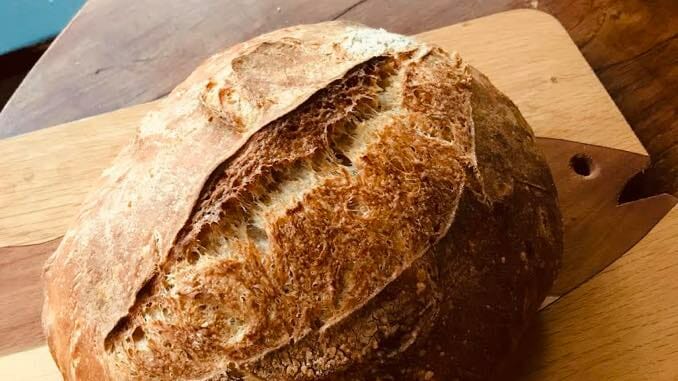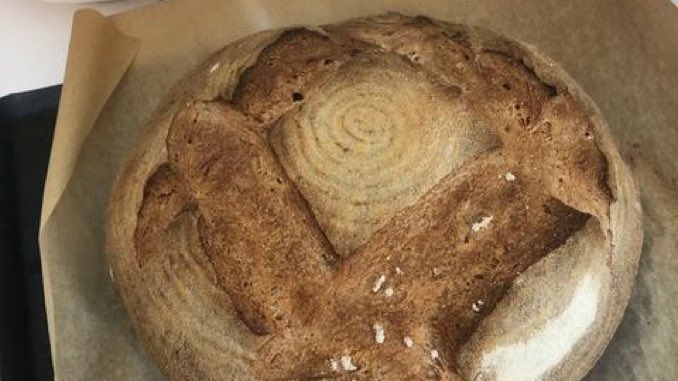The Fall and Rise of Sourdough Culture
Or: The birth of Sarah bat Natan and how she got me through lockdown
Photos by Lisa Jaffe Food Features Sourdough Bread
I named her Sarah, with an H because to me adding the H made her Jewish. At least as Jewish as a sourdough culture could be. I got her from Pam Mandel, a Seattle-based writer who I’ve known since I was about four years old. Hers is named Nathan (thus mine is, in Jewish parlance, Sarah bat Natan, or Sarah, daughter of Nathan). She had been posting pictures of her magnificent sourdough creations on Instagram, and I was looking for alternative date night activities.
During the first lockdown phases of the pandemic, a lot of people turned to baking as a way to kill time. But there were shortages of yeast, among other things. So many people turned to one of the older ways to leaven bread: sourdough. That word was one of the top recipe-related terms on Google in 2020.
Suddenly, people were all over the web posting pictures and stories and questions about sourdough baking. Some talked about the provenance of their starter. There were claims of them being handed down through generations of families—tens, even hundreds of years old. It got me thinking about mine.

Mandel got her baby starter from her friend Knox Gardner, publisher at Entre Rios books and a community activist in Seattle. His starter has no name. “It’s just some flour and water,” he says. “I find the whole naming thing strange.”
Sourdough, like strudel, was, pre-pandemic, something Gardner thought was better left to the professionals. “It may seem counter-intuitive, but working with sourdough, though, helped me become both more a more experimental and yet detailed baker in the kitchen.” He has also found himself noticing more references to bread and sourdough in older poetry. “I would have glossed over them earlier, or not thought enough about the making of bread, the labor involved, and the risk for everyone to have it not turn out.”
Garnder mentions “I wake and feel the fell of dark not day” by Gerard Manley Hopkins, which occurs to him while he is turning his dough.
I admit I had visions of Sarah coming from a long line of starters, but alas, the origin came just one starter generation earlier than Gardner’s, with someone who lives about a half mile from me, Niko Kamoto.
“I felt pretty psychic about it around March of 2020,” she says. “For some reason I got it in my head that I wanted to try baking sourdough during the winter [before]. Without too much digging on the internet, I made up a basic starter recipe in the beginning of September 2019. I fed it, coddled it, created a ton of discard, only to finally give up the end of November. It was fussy, active in fits and starts, and highly unpredictable to bake with.”
She tried again, and her starter stable by early March, just as the first lockdown began. “That was great because by April, the supply of yeast had run out.” She named hers Rainier Beach Ghetto Blaster or RBG. Ostensibly after her neighborhood, the name took on added meaning when Ruth Bader Ginsberg died.
Like many who use starter rather than commercial yeast, Kamoto finds that each loaf is different, but “you automatically know it’s going to taste good. Getting a good rise? The perfect crust? When you are on, it’s like a miracle. When you’re off, well, you have the makings of some great croutons.”
Sourdough has been around for at least 3,700 years. That’s the earliest evidence yet found. It exists, historically, in most places. Exceptions include parts of Scotland and Northern Ireland, where food historian Lucy Long says the cool, salty conditions may have prevented it from being a successful method of leavening. They tended to use other fermentation techniques, like salt risen dough, and turned to baking soda after its invention in the 1800s.
Commercial yeast, which has been available for most of two centuries, is more reliable, and Long says it quickly replaced the wild rising methods used by most people in most cultures. There have been instances where the popularity of sourdough increased, often in times of shortage like during the world wars, and most recently in the 1960s, when hippie and “back to the land” culture—pun intended—rose to prominence.

If I really wanted something with a long provenance, I could have gone over to Ebay and bought one purporting to come from Greece more than 300 years ago, or from San Francisco in the 1810s. For less than $10, either could have been mine. But I have to wonder, would it taste any different? Aside from the rush of “mine is an antique!” what do you gain?
Probably something, genetically; but also probably nothing you can taste, says Maria Marco, PhD, a professor in the department of food science and technology at University of California, Davis. “The microorganisms that were dominant in that starter would have changed over time possibly evolving through gene loss and gain.” While it’s possible something of the original remains in the starter, it’s more probable that it is different. Different ambient microbes, and if the starter has moved any distance, different environment in terms of temperature and humidity, would make for a different starter.
Even the flour we use now is different from what was in use 300 years ago, she says. “What is in your kitchen now and its environment has also undergone change.”
That means that Kamoto’s and mine probably have a lot more in common genetically than mine and the baby I gave to my nephew Dustin. He dubbed it Fizzy Frank, and it lives in his fridge in Port Orchard, a few dozen miles from Sarah as the crow flies.
“We get a lot of aesthetic satisfaction from smelling, tasting and seeing bread,” Long says. “When you have control over the entire process, it’s an act of creation. And when we were all isolated and you find others are doing the same thing, there is a sense of connectedness.”
It’s exactly that feeling that keeps me feeding Sarah. My boyfriend and I make sourdough pizza crust—better than anything I’ve ever had at a restaurant—and occasionally dabble in the two-day process of making bagels. He took a bit of starter from Sarah and dubbed it Isaac. I treasure the pancakes I make with the discard. But mostly, I love seeing what my little sourdough community is baking and look for new ideas. My friend Pam made some English muffins recently that have me considering my weekend breakfast options. And Knox sent me pictures of a really beautiful loaf of rye that made me check my supply of rye flour.
I keep giving out babies. My friend Sharon loved hers—named Rebecca—while it lasted. “I was a little afraid to tell you it died initially.” I’ll make her another starter. And maybe in 10 years, Sarah and her progeny will have expanded their reach beyond the greater Puget Sound. Or maybe not. I guess like politics, all sourdough is local. Local and and totally worth the trouble.
Lisa Jaffe is a freelance writer based in Seattle. She lives with her son and very shouty dog, and if she had known 40 years ago that she could study food history, she wouldn’t have pursued an advanced degree in French Revolutionary History.